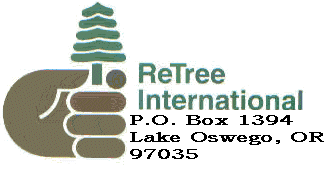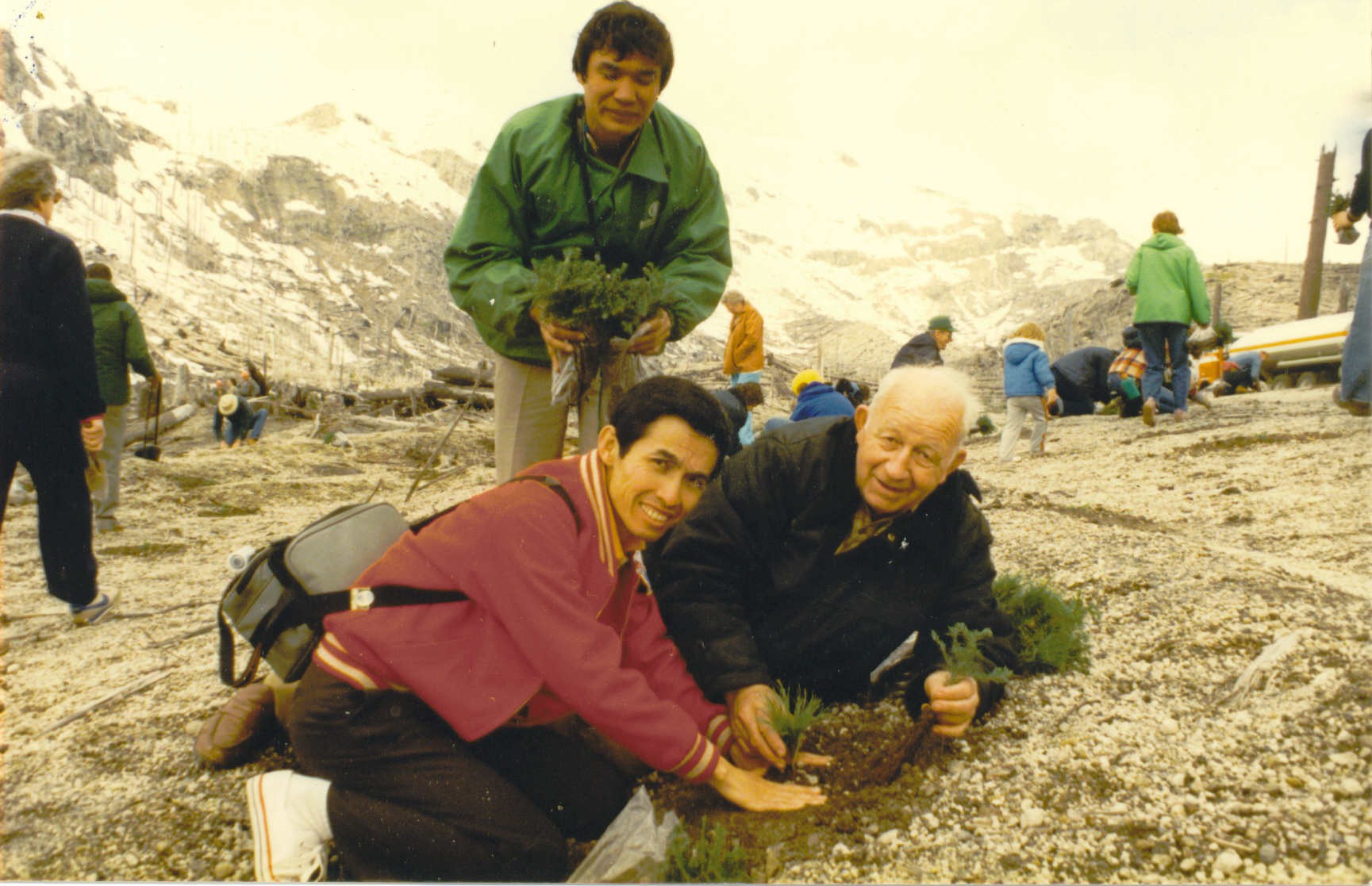
It is the mission of ReTree International to plant forest trees on idle lands around the world by involving people, especially youth, in planting projects and by educating them on the importance of trees and forests.

ReTree International will continue its support of forestry research in genetics, fire and disease control, regeneration and management, seed collection and distribution.
Volunteer support will be sought from youth and service organizations, including Scouting and Lions Clubs International. Service-learning will be promoted among participants to make tree planting a meaningful learning experience, while young people are providing a valuable service to land managers in places where tree plantings are undertaken.
Youth and service organizations will be encouraged to return to the site of the forest tree plantings a few years hence to observe survival rates and general health of the living forest.
The Oregon Travel Information Council administers the Oregon Heritage Tree Program (Oregon Heritage Tree Program) to increase public awareness of the important contribution of trees to Oregon's history and the significant role they play in the quality of our daily life. The Frank Lockyear Memorial Grove was dedicated as a Heritage Tree site on October 22, 2004, in a ceremony held at the Clackamas River Ranger District, on which the Grove is located, at their office in Estacada. There is a plaque on display in the office with information about the grove.
The following is excerpted from Trees for Tomorrow by Frank Lockyear:
--Eventually I advanced from the root pruning gang into the Gardens' propagating house. Here thousands of cuttings were taken from different kinds of shrubs and trees, and potted. One of the species we rooted was western red cedar. They were nice cuttings and did well. One day in 1933, Mr. Lambert came through and told the propagator that most of the cedar should be destroyed because the Garden had too many of them. He ordered that five hundred be put on the burn pile.Those little trees looked so nice, I couldn't even think of them being destroyed. I said, "Mr. Lambert, can I have those little trees?"
"No, Frank. I know why you want them. You'll get yourself a piece of land and start your own nursery and compete with me."
But I still couldn't accept the idea of those little trees being burned. On my day off, I visited the supervisor of the Mt. Hood National Forest and told him my story. I asked if there might be a site in the forest where I could plant the little cedars where even Mr. Lambert couldn't accuse me of trying to compete with him. I said that in this case, Mr. Lambert might let me have them. The supervisor said he thought there might be such a place. He assigned one of his foresters, a Mr. Fullington, to help us. We went up the Clackamas River to a little place that seemed just right.
Back at the Gardens, I approached Mr. Lambert again. This time I told him what I planned to do: get a group of Boy Scouts together and go up the Clackamas to plant the cedar seedlings on Forest Service land. I told him there probably would be some publicity for Lambert Gardens in the deal. That turned the trick. He said to go ahead and take the cedar seedlings. I got about thirty-five Boy Scouts from around the District and we went out and planted those little western red cedars. That was in 1934. My friend, the photographer Allan deLay, took motion pictures of the event. Later, during the war, fires in the area destroyed a few of the trees. But in 1988 or thereabout, the Mt. Hood National Forest historian, Tom Ortman, and I went to look for those that survived. Allan deLay went along. We found some cedars that were of the right age and in the right place, so we figured that some of those original five hundred seedlings had survived through the years.--
In November 2002, ReTree International submitted a nomination for this grove of western redcedar at North Fork Crossing on the Clackamas River Ranger District of the Mt. Hood National Forest for inclusion in the Oregon Heritage Tree Program.

Frank Lockyear was affiliated with the Boy Scouts for more than seventy - six years. Although ReTree wasn't officially formed until 1973, Frank began planting trees long before that. As a Scoutmaster, he involved his scouts in replanting the Tillamook Burn in the 1930's. It's been seventy years since those trees were planted. Since then, millions of trees have been planted, ReTree was founded, and the organization has continued his personal work with the local council to have Scouts become more involved in tree planting as part of their community service projects.
Frank Lockyear was raised on a farm in rural Oregon. He grew up with a love and appreciation of the land. When he moved to the Portland area in his youth he joined the Boy Scouts. He remained an active member of that organization for over 70 years. It was with the Scouts that he first began planting trees. After the great Tillamook fires of the 1930's, Frank's scout troop was one of the first groups to begin replanting the burned over forests. Later he worked in the landscaping business. An old employer of his once had 500 excess western redcedar seedlings he wanted Frank to destroy. Instead Frank arranged to have the seedlings planted on Mt. Hood National Forest land. This began a partnership with the Forest Service that has continued through the years. He went on to run his own landscaping and nursery business and continued planting trees.
After he retired in the early 1970's Frank began travelling. Wherever he went he brought seeds or seedlings and in 1973 he decided it was time to form ReTree International in order to organize his tree planting projects. ReTree was founded with three objectives-
1) Plant forest trees on idle lands around the world wherever they will grow. The only criteria are that these lands are capable of supporting trees, they are set aside for the trees, and that they be protected from browsing and grazing animals.Since its inception ReTree has organized tree plantings all over the world. In order to accomplish this ReTree has developed partnerships with a wide variety or government agencies, organizations such as the Lion's Club, private companies of all types, and private citizens. Frank's motto has always been that he "will call anyone" and usually it requires just a phone call or several phone calls to enlist the assistance of these other parties. The Lions Clubs in particular have proven to be a valuable partner. There are Lions Clubs virtually everywhere in the world and their members have always lent a hand in helping to organize plantings overseas and at home.
2) Involve people, especially young people, in planting projects, and at the same time educate them regarding the importance of trees and forests. Children represent the hope of the earth's forests and it is critical that we adults indoctrinate children early by word and deed.
3) Support forestry research. ReTree tries to help forestry students obtain scholarships and other aid. ReTree will also collect and distribute seeds or seedlings needed by scientists in their work.
ReTree has participated in projects in over fifty countries. Except in special cases, such as plantings in areas with extreme climates or for experimental purposes, native tree species are always planted. The objective is to replant forests as they once were. One of ReTree's foreign projects was a tree planting in Poland in 1980. During that trip ReTree found Boy Scout troops, supposedly not allowed under Communist rule, for the planting. The contacts made there led to a seed exchange between Polish and American foresters which would not have been possible through official government channels at that time. As Frank pointed out, "trees don't know anything about national borders." One of the largest seed exchanges took place with Finland a couple years later. Other plantings have taken place in countries such as Haiti, Thailand, Greece, and much of Latin America and the Caribbean. In Iceland ReTree helped organize a major workshop on tree growth in cold climates as well as conducting a tree planting.
One of ReTree's most important destinations has been Alaska. Over the years there have been numerous plantings throughout the state including an attempt to reforest remote areas such as the Aleutian Islands where trees haven't grown naturally since the last Ice Age. Another one of ReTree's goals is to plant trees wherever they will grow.
The first tree planting on Mt. St. Helen's after it erupted in 1980 was done by Scouts and organized by ReTree. ReTree has also done tree plantings with Native American tribes throughout the west as well as plantings with disabled youth in Oregon and Washington.
Replanting Mt. St. Helen's

Another type of project ReTree has taken on is commemorative tree plantings. The first one took place in Fort Campbell, Kentucky, and was done in memory of American servicemen stationed there who were killed in a plane crash in Newfoundland in 1985. A commemorative planting was also done for the crew of the Challenger space shuttle. In 1992 planting was begun on a Vietnam memorial forest here in Oregon for the men and women who died or are still missing in Vietnam.
In the Pacific Northwest one of ReTree's largest projects is the annual Guy Miller tree plants. Guy Miller was a Scout executive and longtime tree planter who passed away in 1991 and since 1993 Scouts throughout northwest Oregon and southwest Washington hold a series of tree plantings in his memory every winter and spring. On April 20, 2002 the two millionth tree of this ongoing program was planted. ReTree hopes to keep planting trees in the future wherever there is land available that can grow them anywhere on the planet. The world needs trees. They are one of our few renewable resources.
Home
|
Upcoming Events
|
Sponsors
|
Accomplishments
|
Links
|
Board Members
|
How Can I Help?